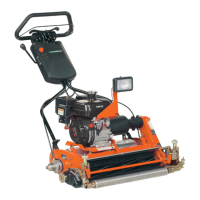ELECTRICAL SYSTEM
10F-11
SECTION 10F. STARTER
GENERAL
The repair of the starter is covered in the engine manu-
facturer’s service manual, which can be obtained
through your local Jacobsen dealer.
STARTER (M1) FIELD TEST
Starter Motor Solenoid
1. Disconnect the brown wire from the starter motor
solenoid (Figure 10F-1).
Figure 10F-1. Brown Wire
2. Set the multimeter to the 20 VDC scale and con-
nect the POS (+) lead to the brown solenoid wire.
Connect the NEG (-) lead to a good ground.
3. Set all of the starter interlock controls in the proper
position for starting.
• PTO switch in OFF position.
• Traction pedal in Neutral position.
• Parking brake in ON position.
4. Turn and hold the ignition switch in the START
position.
The multimeter should display battery voltage
(Figure ).
If no voltage is measured, check the starter inter-
lock system: Neutral, brake, and PTO switches,
relays and wire harness.
Figure 10F-2. Voltage from Start Interlock System
5. Once battery voltage is obtained on the brown
wire with key held in START position, turn key
switch to OFF position and connect brown wire
onto the starter solenoid.
6. Try starting the engine. If starter fails to engage, or
solenoid clicks or chatters, proceed to step 7.
7. Disconnect the white wire on the starter motor
from the wire harness connector.
8. With the multimeter POS (+) lead, touch the brown
wire terminal connected to the solenoid. The NEG
(-) lead should be connected to a good ground.
Turn key switch to the start position and observe
the voltage on the brown wire terminal.
Voltage should not drop below 10.5 VDC, as this
is required to engage the solenoid.
If voltage drops below 10.5 VDC, check battery
condition, battery cable connections at both ends
of cable, engine ground strap, wire harness,
starter interlock switches and relays, shorted
starter motor, seized engine.
If battery voltage was observed and starter did not
engage, the start solenoid or starter motor is at
fault. Proceed to step 9.
10F

